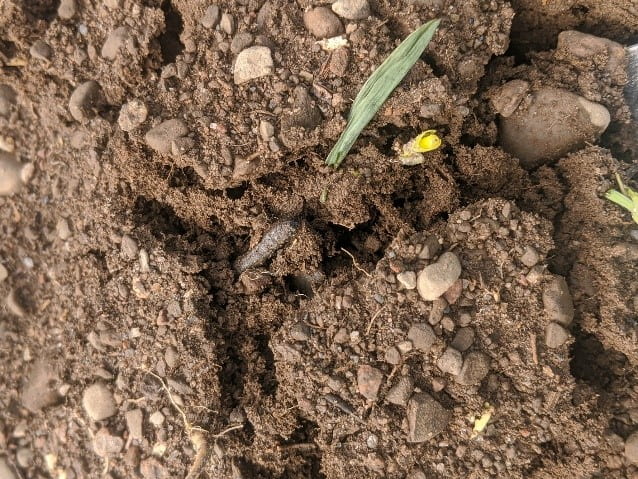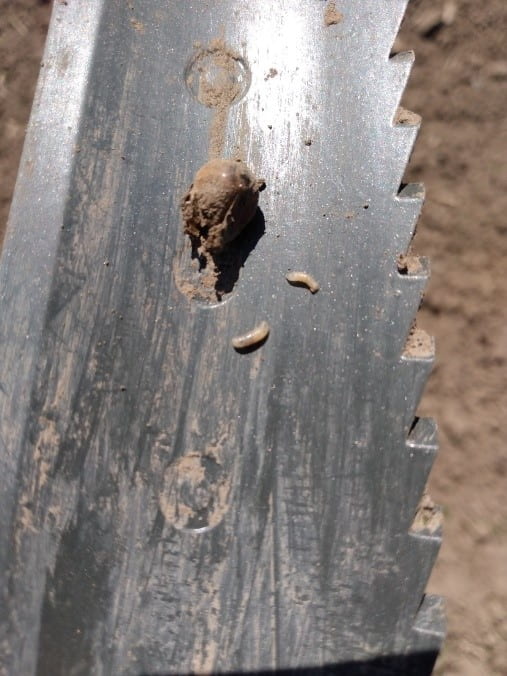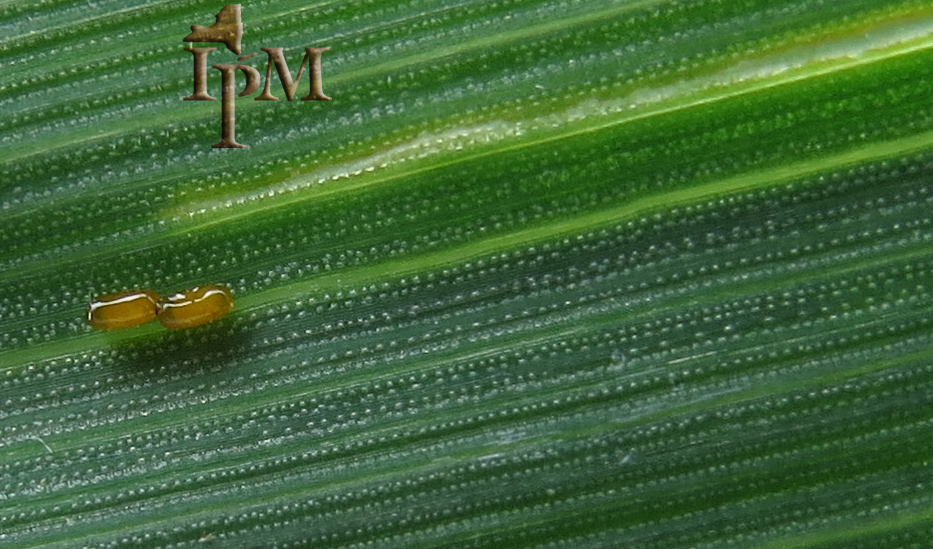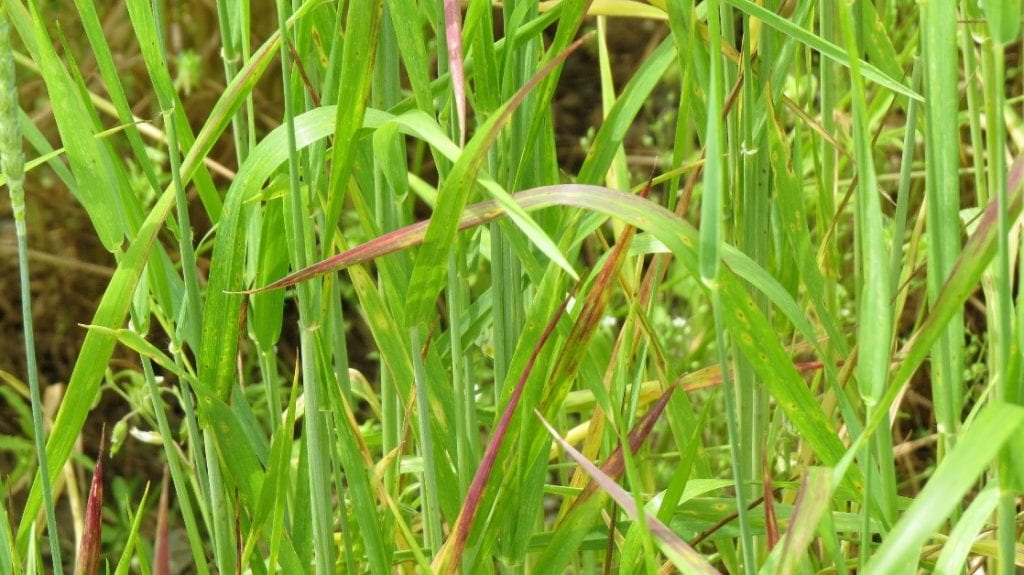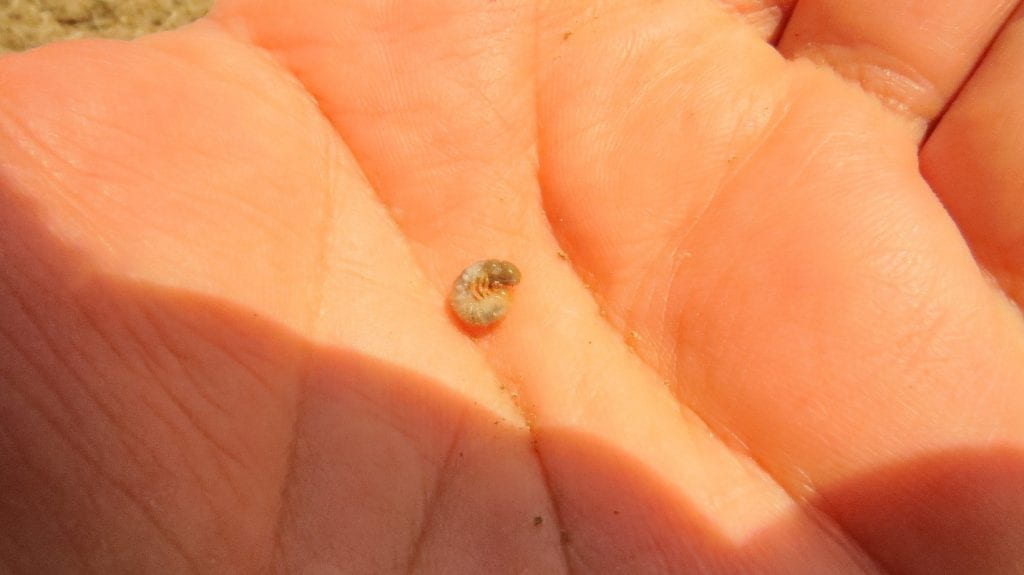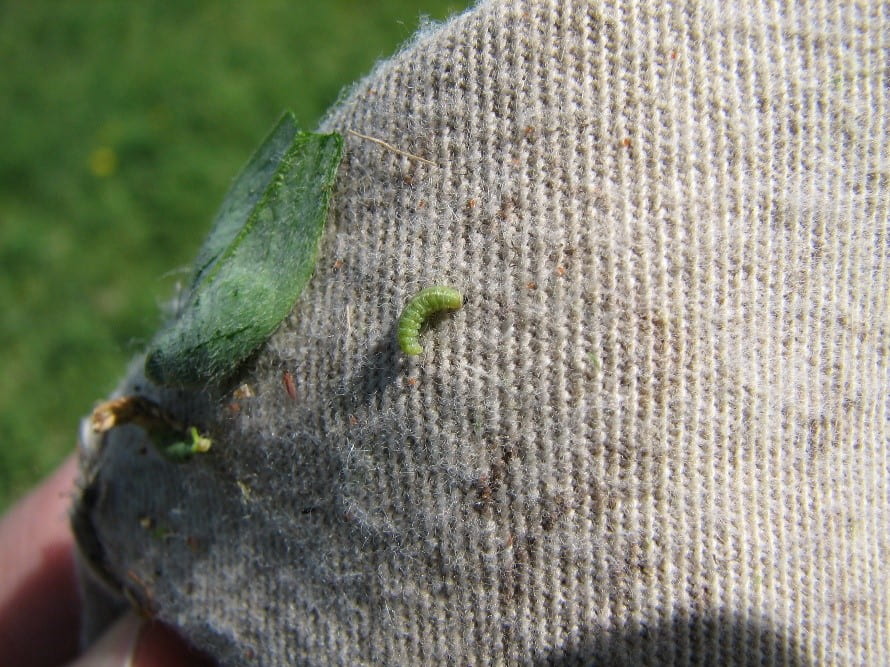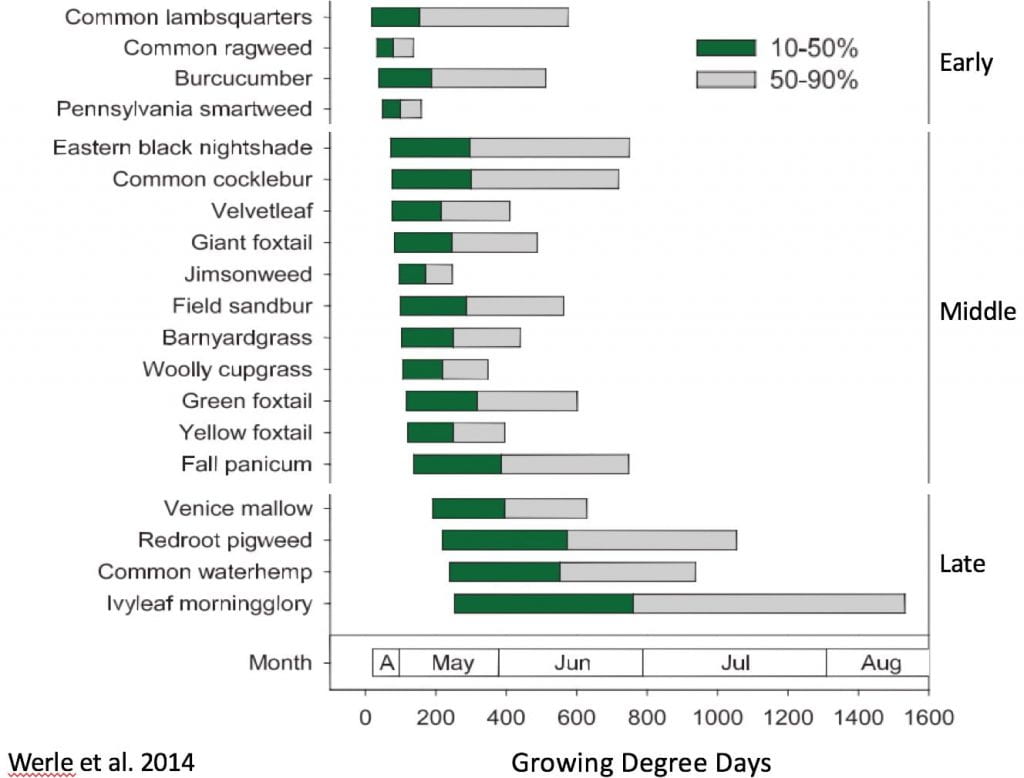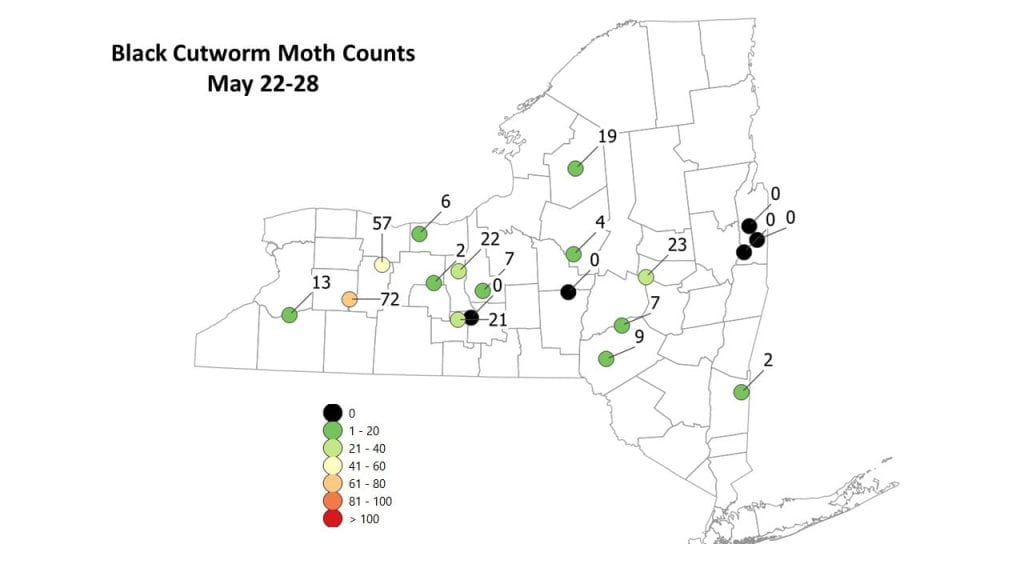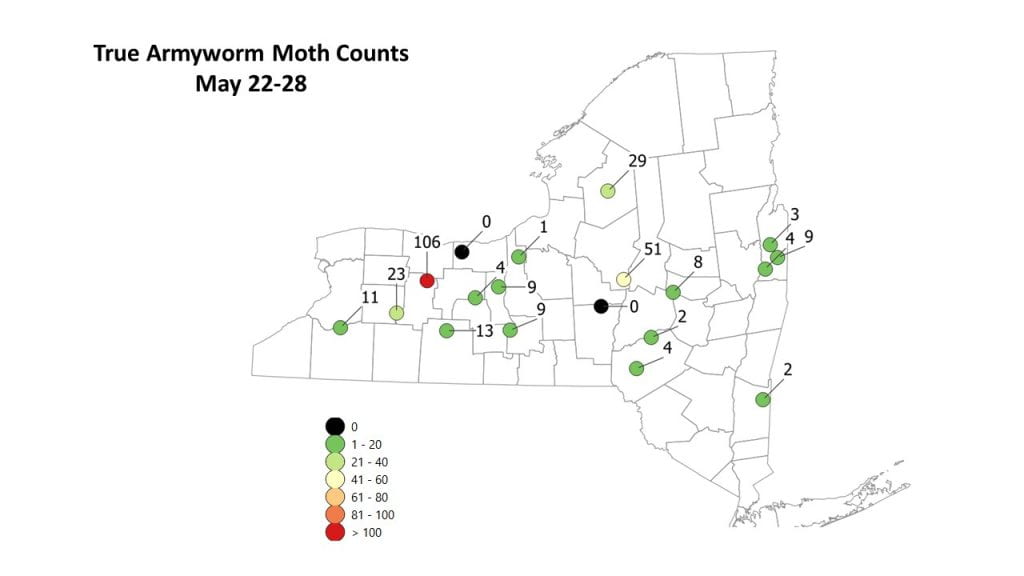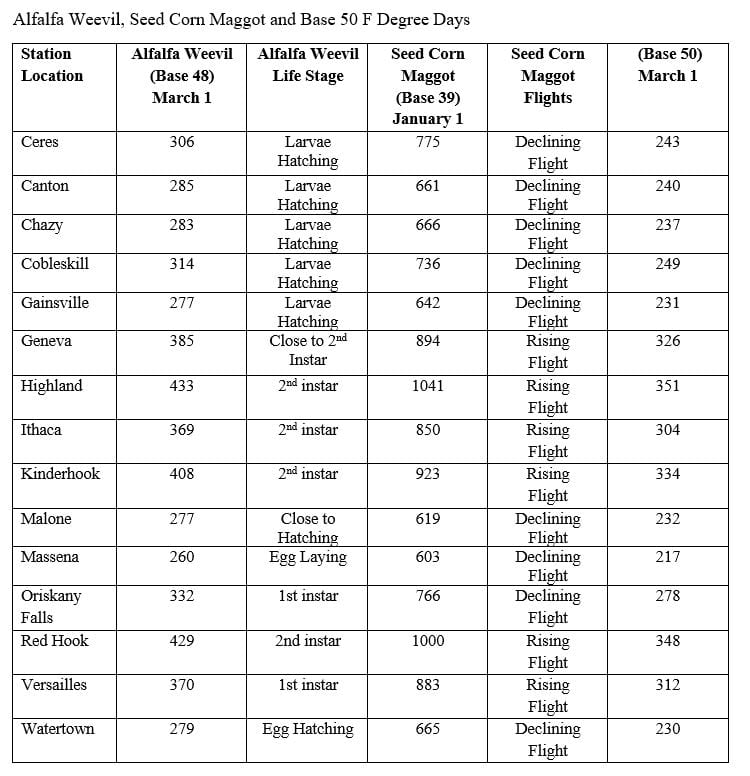Contents
View from the Field
Black Cutworm
McClelland’s Agronomics report black cutworm damage over the economic threshold of 5% of plants cut in a cornfield in southern Jefferson County. This field will be treated with an insecticide. There have been other large pheromone trap captures, and these moths will potentially lay eggs in cornfields. Therefore, its’ is a good time to start scouting for black cutworm!
Photo by: McClelland’s Agronomics
True Armyworm
There were very large pheromone trap captures of true armyworm across the state this past week. Again, while this week’s capture will not results in larvae for a while, we have had other flights of moths earlier in May, which may have already laid eggs. Make sure to start looking for armyworm larvae while they are small
Seed Corn Maggot
Mike Hunter (CCE Northern NY Team) reports a corn stand failure because of seedcorn maggot. The seed planted in this field was not treated with an insecticidal seed treatment. Instead, the grower used an in-furrow insecticide. This infestation level was very high and the grower will be replanting the entire field. A nearby field was also moderately infested but didn’t require a full replant. There are other reports of low to moderate levels of infestation of seed corn maggot in two cornfields in central and eastern NY. Be sure to inspect skips in planted rows by V2 growth stage to find evidence of seedcorn maggot damage, and keep in mind that we may experience damage from the second generation of seedcorn maggots in newly planted corn or soy fields
Seed Corn Maggot
Photo by Mike Hunter
Cereal Leaf Beetle
Mike Stanyard (CCE Northwest Dairy and Field Crops Team) reports finding cereal leaf beetle eggs and adults in an oat field. These are at low levels currently.
Photo by Ken Wise (NYS IPM)
Powdery mildew and barley yellow dwarf
Christian Malsatzki (CCE Ulster County) reports finding low levels of powdery mildew and barley yellow dwarf disease in small grains in Ulster County. For more information on this see, last week’s pest report.
Barley Yellow Dwarf
Photo by Ken Wise (NYS IPM)
Powdery Mildew on Wheat
Photo by Ken Wise (NYS IPM)
White Grub
Ken Wise (NYS IPM) reports finding low levels of white grubs in an emerging cornfield in Dutchess County. Generally, white grubs do not cause much damage unless it is a first year field after sod.
White Grub
Photo by Ken Wise (NYS IPM)
Alfalfa Weevil
Aaron Gabriel (CCE Capital District) and Ken Wise (NYS IPM) report finding low levels of 1st and 2nd instar larvae of alfalfa weevil in alfalfa. Because of the cold spring, alfalfa weevil will most likely not be a big issue in the first cutting of alfalfa. HOWEVER, watch the forage regrowth because alfalfa weevil could be an issue for second cutting.
Alfalfa Weevil Larva
Photo by Ken Wise (NYS IPM)
When Can I Expect Certain Weeds to Emerge?
Bryan Brown, NYSIPM
With a warm week of weather across the state, we’re starting to see new flushes of weeds. I even saw some early waterhemp popping up! It’s good to know when your problematic species emerge so you can be one step ahead of them with a residual herbicide program or be ready to hit them early with post-emergence applications or cultivation. Some of our newly problematic weeds, like waterhemp, need to be controlled before they reach 4-inches tall! (See our 2019 results in corn and soybeans.)
Cornell is working on a model to help predict when various weeds will emergence, but in the meantime check out this graph from the University of Nebraska (adapted from Werle et al 2014) that gives a rough estimate of when you can expect to see certain weeds.
Note that the months are shortened based on how many heat units, or Growing Degree Days, they receive. To determine how many Growing Degree Days you’ve accumulated at your farm, check out http://newa.cornell.edu/ , click on a weather station near you, select Growing Degree Days (Base 50F), and look under the “since Jan 1” column.
Black Cutworm Moths Caught
True Armyworm Moths Caught
Alfalfa Weevil, Seed Corn Maggot and Base 50 F Degree Days
Degree days for alfalfa weevil and seed corn maggot
Alfalfa Degree Days Life Stages
(Base Temperature 48F)
Egg Hatch 280
Instar 1 315
Instar 2 395
Instar 3 470
Instar 4 550
Cocooning 600
Pupa 725
Adult Emergence 815
Seed Corn Maggot Flight Degree-Day Model for Egg Laying
| Base Temp = 390 F | Peak 1st Generation | Seed corn maggot fly free degree days | Peak 2nd Generation | Seed Corn maggot fly free degree days | Peak 3rd Generation | Seed Corn Maggot fly Free degree days |
| degree days | 360 | 810 | 1,080 | 1530 | 1800 | 2250 |
Source: Insect IPM for Organic Field Crops: Seed Corn Maggot by Katelin Holm and Eileen Cullen
Black Cutworm and True Armyworm Degree Days
Degree days for Black Cutworm and True Armyworm by Location of Trap
Black Cutworm Degree Days (Base 500 F) Lifecycle Growth Stages
Degree Days Stage Feeding Activity
0 Moth Capture Egg Laying
90 Eggs Hatch
91-311 1st to 3rd Instar Leaf Feeding
312-364 4th Instar Cutting Begins
365-430 5th Instar Cutting Begins
431-640 6th Instar Cutting Slows
641-989 Pupa No feeding
Source: University of Minnesota Insect Pest of Corn-Stand Reducers Black Cutworm
True Armyworm Degree Days (Base 500 F) Lifecycle Growth Stages
Degree Days Stage Feeding Activity
0 Moth Capture Egg Laying
113 Eggs Hatch
612 Larval stages Leaf Feeding
909 Pupa No feeding
Clipboard Checklist
Keith Waldron, NYS IPM
General
*Walk fields to check tile flow, check and clear drainage outlets. Look for line breaks
*Note and record location of wet areas on field maps or aerial photo for future tiling considerations and crop decisions, check for areas of soil erosion
*Pre-plant weed evaluation, timing cultivation and/or pre-plant weed management
*Watch for early season weeds: winter annuals, chickweed, henbit, field penny cress, shepherd’s purse, giant and common ragweed, purple deadnettle, lambsquarters, redroot pigweed, velvet leaf, Pennsylvania smartweed, common sunflower, quackgrass, foxtail
Alfalfa:
*Evaluate established legume stands for winter damage (thinning stand, frost heave, Brown root rot), determine average alfalfa stand count adjust crop plans if necessary
*Monitor for alfalfa weevil, crown or foliar diseases
*Monitor new seedings for Pythium blight and Phytopthora Root Rot.
*Monitor for Alfalfa Snout Beetle (In Oswego, Jefferson, Cayuga, Wayne, Lewis, St. Lawrence, Clinton, Essex, and Franklin counties)
Small Grains:
*Monitor winter grain fields for over wintering survival (snow mold and other cold injury issues), weed issues (such, as winter annuals, corn chamomile and chickweed), growth stage, number of tillers, foliar diseases (powdery mildew, rusts)
*Check stands for soilborne virus diseases, Wheat spindle streak mosaic and Soilborne wheat mosaic, check for signs of powdery mildew or other maladies, cereal leaf beetle, weed escapes, goose damage
Corn:
*Prepare land and plant corn as conditions allow
*Pre-plant weed evaluation, timing cultivation and/or pre-plant weed management
*Emergence: assess stand, population count
Soybeans:
*Prepare land and plant soybeans as conditions allow
*Pre-plant weed evaluation, timing cultivation and/or pre-plant weed management
Pastures:
*Check and mend fences as needed.
*Check crop growth
*Monitor fields for invasive species, plants harmful to livestock
*Review/Plan rotation system
Equipment:
*Remove / clean soil and crop debris from equipment
*Arrange for custom weed control or check your own application or cultivator equipment for repairs.
*Carry appropriate / necessary NYS DEC and EPA required documents: (pesticide applicators license, pesticide labels, MSDS sheets, etc.) with application equipment
*Calibrate:
-planting equipment – maintain records on planting rate per field
-manure spreaders – maintain records on amount spread per field
-pesticide application equipment – Check nozzles, pumps, etc., recalibrate pesticide application equipment before use.
Storage:
* Check stored grain bins for temperature, moisture and signs of mold and insects. Aerate, core, transfer grain or treat as necessary
*Check forage allocation and anticipate feed program adjustments as forages from previous year are used up
*Plan where forages should be stored for optimum allocation next feeding season


